2nd place
Jerry Kler Architects
Jerry Kler - Cross Pollination
As the name suggests, cross pollination happens when something grows or is stimulated by the introduction of a different element. To that end, this project is about providing affordable living spaces and creating a community using manufactured housing modules. Today, home typically means single-family residences but in the future, it stands for density and innovative construction.
Read moreThe density required to develop the site, the construction method and the confluence of light, air, safety and the interaction of the ultimate users generated the architectural design. There was no attempt to design an unbuildable fantasy. Instead, the emphasis was on outdoor green areas and the animation of the exterior façade with a richness of materials and color, along with a construction method of producing small, affordable spaces.
Since space size can dictate monthly rental costs or purchase prices, the design scaled down unit sizes to a 500 sq.ft. studio and a 1,000 sq.ft. one-bedroom unit. Each has a kitchen, bathroom, storage area, balcony and roof access, while making the project economically feasible. To enhance any infill site, green areas were developed as vertical walls for both shading, material richness, and to soften the exterior with greenery connected to each unit. The same concept would also configure as two or three bedroom residences.
We chose a low to mid-rise height for the scale and the massing possibilities. Infill sites usually lack setbacks, so the project design filled the site to maximize residential square footage. Open space at the ground level as well as the roof has been developed as an activity center, a roof garden and a community gathering space. Above this roof garden is a shade device that holds solar panels running the length of the roof. These panels are expected to provide most of the electrical needs for the units. The energy-saving elements are illustrated in the submitted graphics.
Small balconies are exist alongside the glass-walled living areas so they are light-filled with visual access to view corridors. These terraces provide private, sheltered areas and accessibility from the living areas. The vertical garden walls give residents privacy from the adjacent neighbor.
This proposal utilizes both an interior courtyard, acting as a private, outdoor neighborhood between the buildings, and a community roof garden and walking area for the whole complex.
At ground level between the buildings, there are a myriad of proposed activities to serve the complex including a small amphitheater for adult and children’s plays, a children’s play area, an exterior exhibition space for the presentation of artwork on a rotating schedule, a courtyard and fountain with seating for conversation and outdoor reading, gardens and landscaping, all adjacent to the indoor facilities described in the site plan. They include childcare, community workshops, and art studio and exhibition spaces. All of these uses interact with one another both indoors and outdoors to enhance the richness of cross pollination.
The roof gardens give views along any city corridor. These areas include private seating with integral shading, small and large green areas of foliage and trees and dog runs. Because of the shape of the site, the roof gathers spaces that would be difficult to articulate on small sites and combines them into a usable public space spanning all four buildings. The garden holds vegetation, soils, and a protective membrane so it can function as an urban green roof. A bridge over the open courtyard spans between both building blocks for easy access to both sides.
The project was designed for transit users and bicycle transportation. There is some below grade parking.
Instead of ground floor retail, there are areas are for fitness centers, night classes where teachers visit the complex so residents do not have to travel, craft work, game rooms, art studios and on-site childcare. The middle of the building is for residential lobby access. Each building has a mini-parklet along the street exclusive to the neighborhood. These spaces are small in comparison to other blocks and lend an intimate scale and interaction compatible with the neighborhood.
For this imaginary site, there are 9 residential units in each building, 6 studios and 3 one-bedroom units for a total of 27 units.The drawings, which are part of this submission, clarify the intent of the uses, height and the bulk of the project.
The intent is to enrich the fabric of the neighborhood with a design reflecting affordability, interaction, street life and a variety of neighborhood amenities.
Each building is broken into vertical projections with a pronounced division of glass bays with a clear base, middle, and top as defined by the rooftop garden. The units are articulated with windows, projections, and balconies. All of these elements create shadows and defining profiles.
On the street and courtyard elevations, more than 70% of the frame is devoted to operable windows and glass, even in the exiting stairways. The ground floor and entrances are purely glass, giving a transparency to the entire facade. All of the ground floor community spaces are accessible from the street at the grade of the sidewalk.
For more information
on the winning designs, contact Helen Malani at
hmalani@nnwa.us
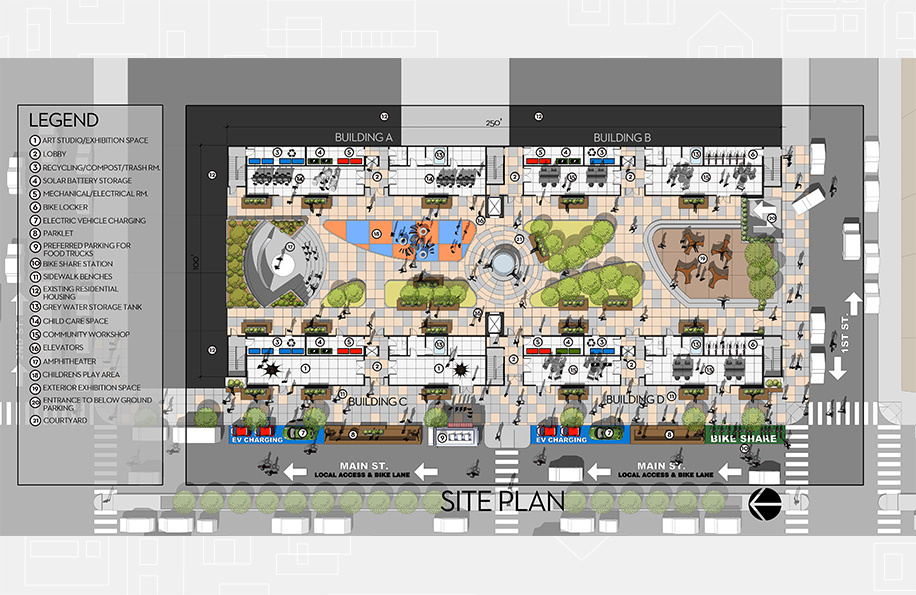
Interior courtyard creates a sheltered space between the buildings with an amphitheater, children's play area, exterior exhibition space and access to community workshops and child care on the ground level.
Street Amenities:
1. Electric vehicle charging station provides community access to shared electric vehicles, powered by onsite renewable energy.
2. Bike share station creates an expanding network of bike share stations around the city to reduce the need for individual car use within the city.
3. Parklet encourages stronger pedestrian use of street and sidewalk while enhancing local business.
4. Prefered parking for local food trucks supports regional economy, diversity and culture.

Solar and rain water harvesters on roof pavilion common area provide an onsite renewable energy and water source for landscaping on building facade and roof level.
Native and drought resistant landscaping reduces water demand and creates a habitat for native birds, butterflies and insects.
Environmental education teaching garden is a natural fit to heighten environmental education and provide a local source of food for urban dwellers.

500 s.f. studio units include built-in storage, a fold down bed, furniture on casters to encourage a flexible layout and a private deck with garden.
1000 s.f. one-bedroom units expand footprint of studio to accommodate live-in units for elder care and a fully accessible private deck, bathroom and kitchen.
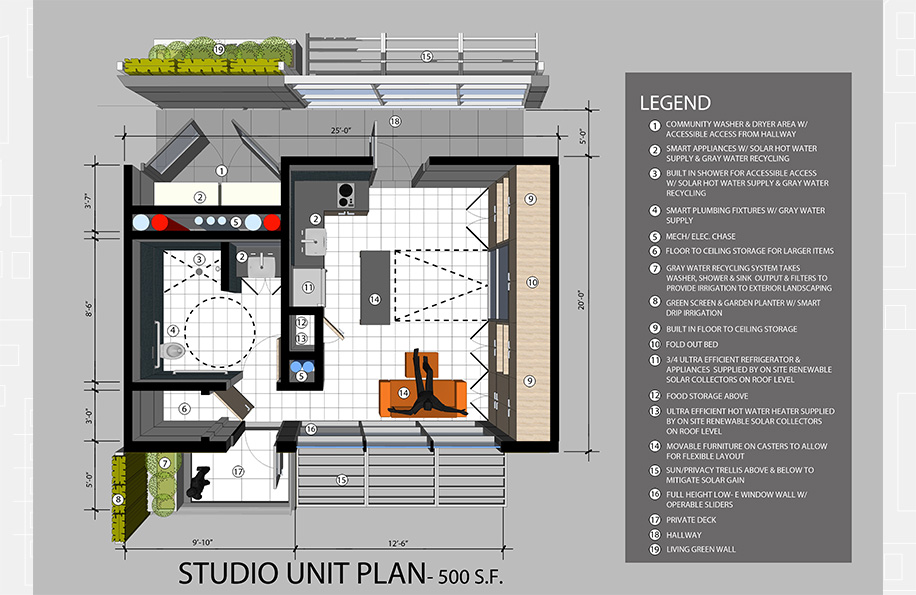
Smart appliances with solar hot water supply and gray water recycling reduce the need for potable water demand and are on the public utility grid for wastewater removal.
Fold out bed allows users to maximize different uses and zones of unit for best flexibility.
Recycled content, rapidly renewable materials and low VOC interior provide for better long term occupant health.
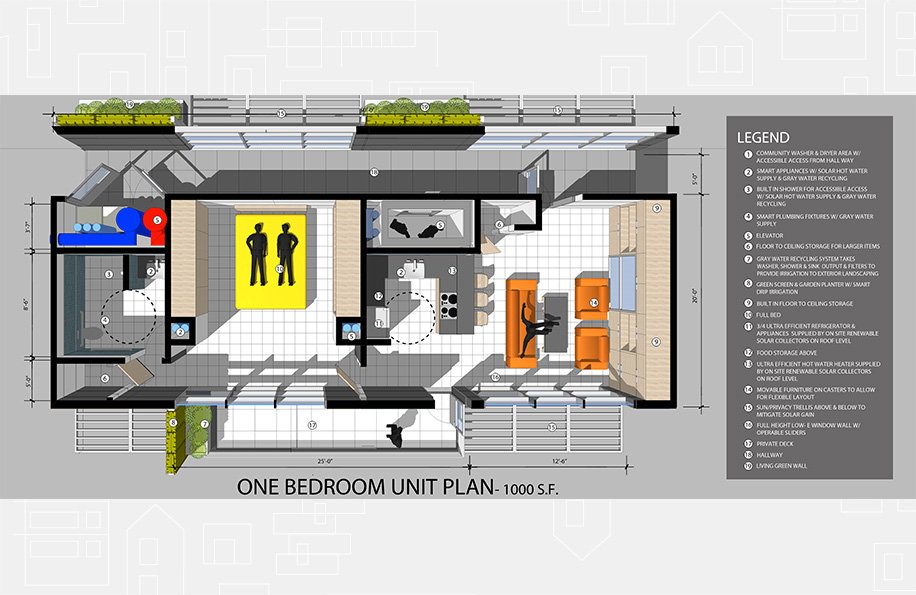
Gray water recycling system takes water out of washers, showers and sinks and filters it to provide irrigation to exterior landscapes.
Ultra efficient hot water heater supplied by on-site renewable solar collectors on roof level.
Green screen and garden with smart drip irrigation recovered from gray water.
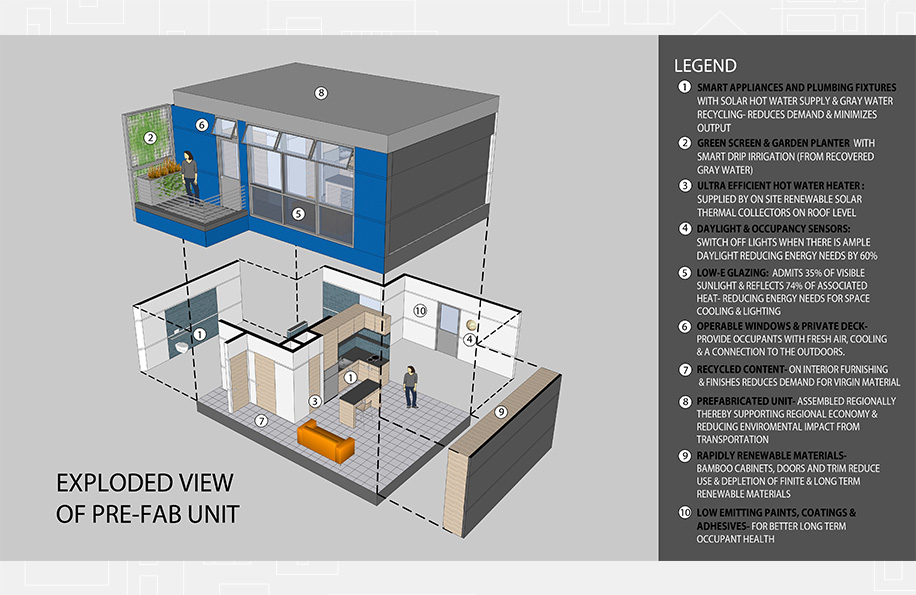
Smart appliances and plumbing fixtures with solar hot water supply and gray water recycling reduce demand and minimize output.
Daylight and occupancy sensors switch off lights when there is ample daylight, reducing energy needs by up to 60%.
Rapidly renewable materials like bamboo cabinets, doors and trim reduce use and depletion of finite materials with long-term renewable materials.
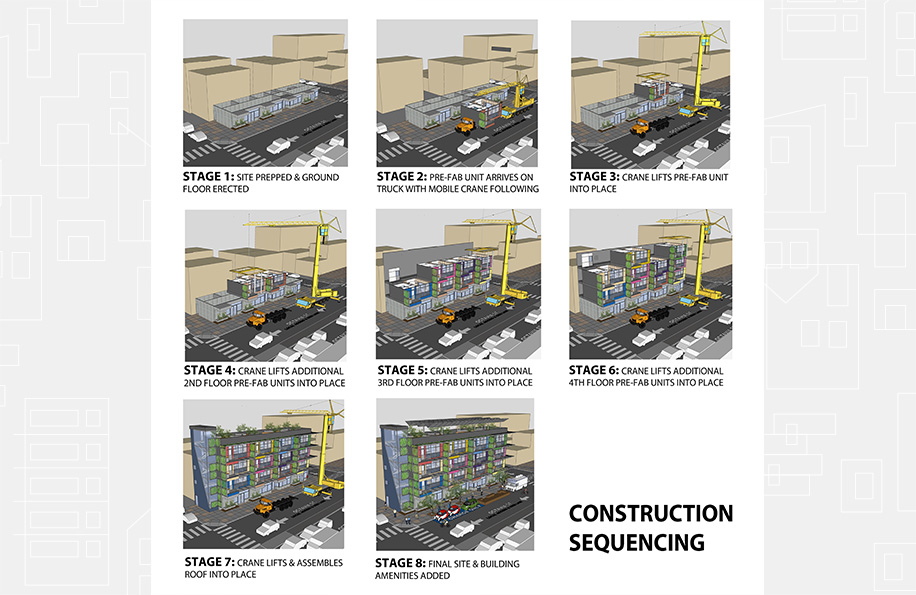
1- Site prepped and ground floor erected.
2- Prefab unit arrives on truck with mobile crane following.
3- Crane lifts prefab units into place.
4- Final site and building amenities added.
Prefabricated unit is assembled regionally, thereby supporting regional economy and reducing the environmental impact from transportation.
Vertical gardens provide privacy between outdoor decks with green screen fed by drip irrigation from rainwater and filtered grey water.
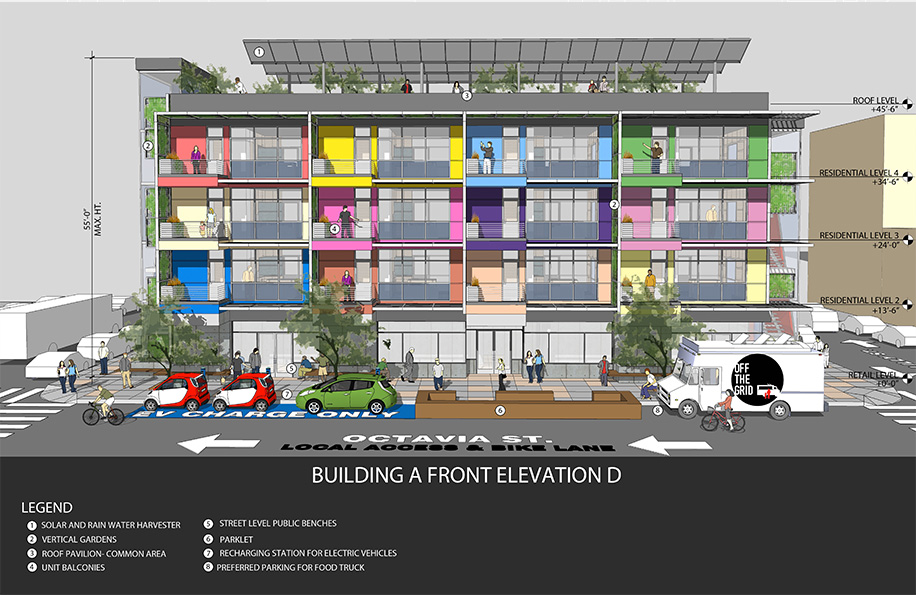
Solar and rain water harvesters on roof pavilion common area provide an onsite renewable energy and water source for landscaping on building facade and roof level.
Unit Balconies provide private, outdoor space for residents.
Site amenities on street level include parklet, electric vehicle charging station and prefered parking for food trucks.
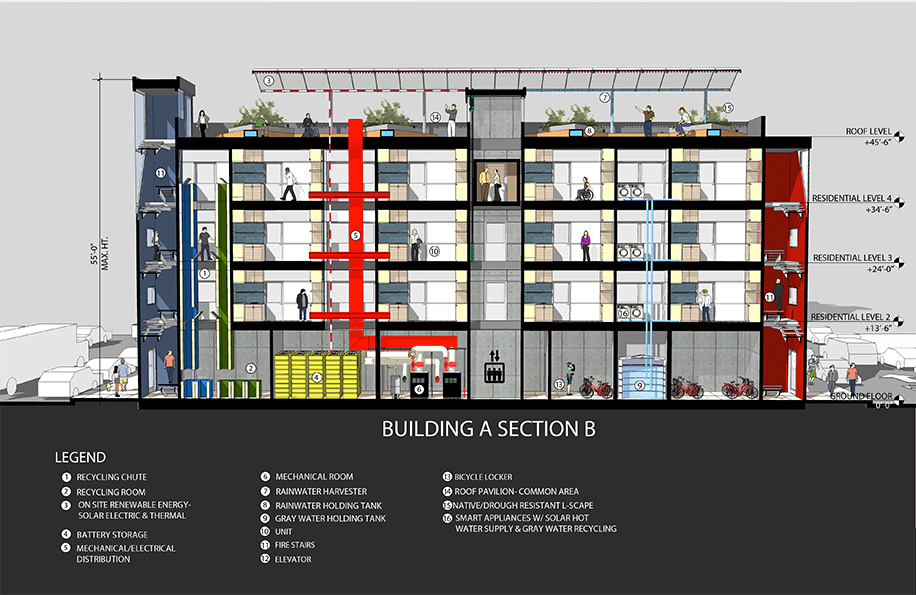
Solar electric and solar thermal provide on-site renewable energy at roof level that is retained for future use with battery storage at ground level.
Rain water harvesting on roof provides water source for landscaping on building facade and roof level.
Gray water holding tank stores, filters and redistributes water from sinks and showers to non-potable uses such as toilet flushing, fire suppression systems and landscape irrigation.
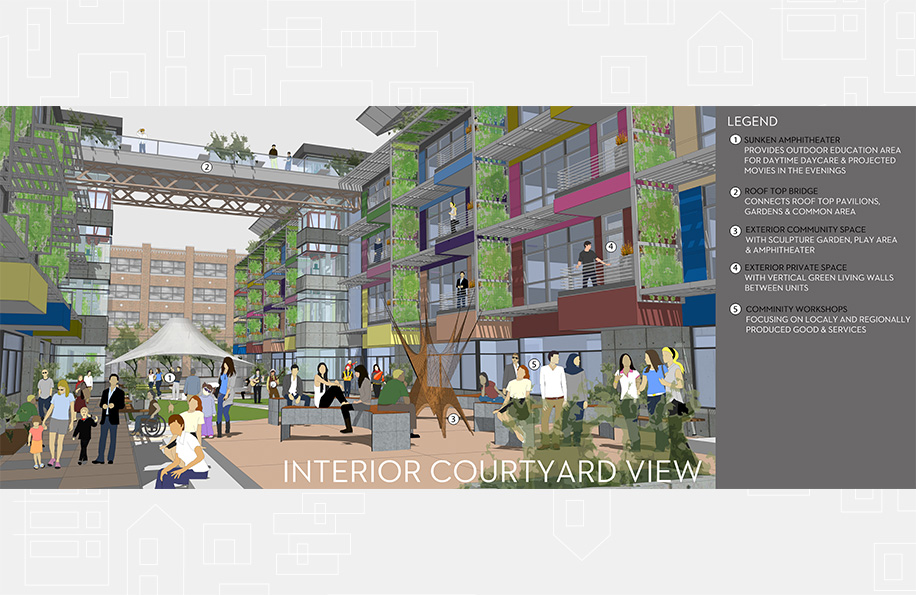
Sunken amphitheater provides an outdoor education area for daytime daycare and projected movies in the evening.
Exterior community space includes a sculpture garden, play area and community workshops.
Exterior private space provides occupants with a connection to the outdoors.










